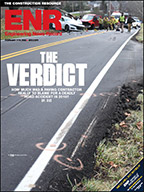Melching agrees that American Architectural owed back taxes due to errors by its prior accountant but adds that Diamond Indemnity's refusal to back it was the key factor that forced the contractor to file for bankruptcy protection in federal court in Philadelphia.
With some help from its surety, the company could have pulled through. "We were duped," said Melching. "We had done $800 million worth of work over 35 years. We had paid for hundreds of millions of dollars of bonds. Now Diamond Indemnity has put us out of business."
Rutledge’s Past Activities
Little is known about Diamond Indemnity's leader, a Melde Rutledge, whose résumé apparently includes a fraud-related conviction and two jail sentences in Washington, D.C., in the 1980s.
According to Federal Bureau of Prisons records, Melde Rutledge Jr. was convicted in 1986 in District of Columbia District Court of interstate transportation of fraudulently obtained property and served a six-month sentence. A judge in 1989 subsequently sentenced Rutledge to another 14 months in jail for a probation violation.
Rutledge may have run into trouble in other places, too. The Indianapolis Star reported in February 1988 that prosecutors or police had begun an investigation into alleged misuse of student-aid funds by a "Melde Rutledge, Jr., Fort Wayne, who tried to set up a chain of trade and technical schools." A man answering a cell-phone number for Melde Rutledge, obtained by ENR, said he no longer uses the number and was unfamiliar with the Diamond Indemnity transactions.
Some individual sureties, such as corporate sureties, operate through licensed brokers, and, together, they function as a network. The line between broker and underwriter observed in corporate surety, however, can become blurred with individual surety, which may operate under multiple business entities. To back the guarantee, some individual sureties prefer reinsurance, trust receipts and notes secured by institutions whose address may be no more than a mail drop. The money trail is often obscure.
The National Association of Surety Bond Producers says it has been battling individual surety and a steady flow of fraud for years. Prosecutions for surety fraud are relatively rare; one of the most recent involves a former insurance underwriter in New York state which was sentenced to prison in 2009 for taking in $22.7 million in premiums on $545 million worth of bonds.
Johnson, in a deposition taken a year ago by Melching's bankruptcy attorney, provided a complex account of his work and his colleagues. Although Johnson believes his signature was used by others at the firm without his permission, he says he was nearly certain the assets backing Diamond Indemnity bonds were as solid as the bedrock beneath Manhattan.
During his deposition testimony about the American Architectural bankruptcy, Johnson talked of attending meetings in New York City with officials of Lend Lease and other big construction managers. At the time, Johnson's position was that he was "defending the bonds."
"Let's cut to the chase," he said during the deposition. "That's why we are here defending the bonds. There is an accusation made at the Lend Lease meeting that it was fraud, and so on and so forth. ... I'm not going anywhere, and I'm pretty confident in the assets that's [sic] backing the bonds." Among other things Johnson promised was that he would meet with Polec and another Diamond Indemnity official to move the claims process forward. When it came to verifying assets backing the guarantees, Johnson couldn't answer definitively.
"Can you tell me what your firm did to segregate a value of $7.1 million" for the bond for the Lend Lease project? asked American Architectural's lawyer.
Replied Johnson, "That would be a question for Melde Rutledge."










